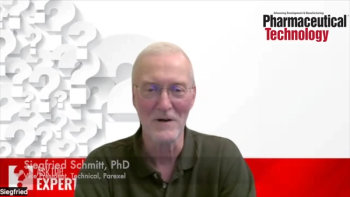
- Pharmaceutical Technology-11-02-2018
- Volume 42
- Issue 11
Don’t Let CMC Oversights Derail Drug Development
Experts share best practices, and war stories, for a crucial but often underappreciated part of drug development.
New drug development is so challenging that it’s hard to blame manufacturers for seeking shortcuts. But one area that cannot be given short shrift is chemistry, manufacturing, and controls (CMC) strategy, which offers a blueprint for taking a drug from the lab to clinical stages and through to commercial manufacturing.
“CMC is the most underappreciated aspect of the whole drug development process, but it can make or break development,” says Ed Elder, director of the University of Wisconsin’s pharma experiment station, which performs early-phase development, preformulation, and formulation work for both small and large molecules.
“Large pharma companies are unlikely to make mistakes due to the resources invested early in program management. They generally have much more experienced personnel and turn to consultants primarily to supplement their staff when timelines accelerate,” says Christopher Bussineau, senior consultant with Biologics Consulting Group, Inc.
“Smaller companies, especially technology innovators, do not have the same number of experienced people on staff or too few staffers with the specific experience required for the drug that they are developing,” he says. Bussineau considers the case of a start-up company that is developing a novel topical formulation that contains a well-characterized protein as an active ingredient, with staff that formerly worked in the cosmetics industry. This group can fail to assemble an analytical package that is robust enough to characterize and control the product. The result, Bussineau says, puts too much risk on the product by, for example, not knowing the stability-indicating assays, not identifying significant impurities, and setting up inadequate formulation recipes. “Companies with limited budgets and experience may force short development timelines that compromise assay qualification and validation, as well as supplier and material qualification; facility and equipment qualification; storage conditions; tech transfer; and process validation,” he says.
Although Big Pharma has done well with CMC over the years, as it moves away from a focus on R&D to one that emphasizes acquisition strategies and licensing, the picture may begin to change in the future, says Elder. Smaller innovative companies do not always understand the importance of having a clear CMC strategy. “Some small biotechs take the approach of ‘Let’s run as fast as we can with whatever works, and if there’s a problem, we’ll deal with it later,’” he says.
Small biotechs should learn from Big Pharma that performing extensive due diligence on CMC is crucial before an asset is acquired. This is necessary in order to protect the investment, says Bussineau, especially if the technology is outside of the company’s area of expertise. “It is possible for companies to buy a process that cannot be scaled up; has dozens of impurities that were previously undetected by the seller’s CMC quality-control group; may not have sufficient stability; or that may have been created with an uncharacterized cell bank,” he says.
Expensive shortcuts
FDA’s accelerated review process, part of the 501(b)(2) approval pathway, may have made it more tempting to take shortcuts that, in some cases, have added millions of dollars and months if not years to development timelines. This is reflected in the growing number of Complete Response Letters (CRLs) that FDA has issued to manufacturers. CRLs put a temporary stop on a drug’s approval until specific issues are addressed. For the past few years, as the complexity of drug formulations has increased, FDA reviewers have issued more CRLs that directly cite CMC deficiencies.
According to a recent study that analyzed CRLs issued between January 2017 and May 2018 (1,2), FDA issued 33 CRLs for 25 new drug applications (NDAs), six biologics, and two complex generic-drug applications. Of the 24 CRLs that manufacturers were willing to talk about, 25% reflected failures within the manufacturer’s CMC program. Eighty percent of the CRLs were issued to small companies, and 80% were for drug applications that used FDA’s 505(b)(2) approval pathway (2).
“Timelines are very crunched, especially now with accelerated approvals,” says consultant James Blackwell, principal of Windshire Consulting Group. It’s essential that drug developers think through any process, go through it step by step and unit operation by unit operation to determine risk and predict where issues will show up during scaleup or technology transfer. “Operating companies must be proactive and drive their CDMO [contract development and manufacturing organization] partners to do this [with them],” Blackwell says.
Internal metrics
More telling than any regulatory failings are the internal metrics that won’t be visible to anyone outside the organization, says James Bernstein, founder and principal of Live Oak Pharmaceutical Services. Questions to ask, he says, include the following:
- How often do we have out-of-specification (OOS) results?
- How often do we have reworks on batches of drug substance or drug product?
- How often have we had to reformulate the product?
- Have we had a failed manufacturing batch?
Any one of these should be considered a red f lag, Bernstein says. Bussineau suggests asking the following questions as well:
- Are we doing sufficient trend analysis to know when it is necessary to revalidate the process?
- Do we know the cost of nonconformance, and is it keeping total cost of goods sold (COGS) from decreasing over time?
- Do the product lifecycle plans include process improvements or equipment changes?
Have a clear target product profile
Given the complexity of CMC, the best way to develop a clear strategy is to base it on a target product profile, which looks holistically at what you’re trying to achieve, says Elder. Questions to address include the therapy, patient population, and understanding the physical chemical characteristics of the drug and how that plays into all those factors, he says.
In addition, cost elements and intellectual property protection must also be considered. “You need an understanding, not only of the basic science of CMC, but how that fits into preclinical strategy, clinical strategy, regulatory strategy,” says Elder.
Every compound and every development program will be different. “It’s a matter of understanding what information is needed and when, and generating it in real time. Based on what you learn, you can adjust that strategy as you go so that you can make good decisions on whether or not to move forward at each step,” he says.
Errors of omission are typically the biggest problem. “Many developers fail to anticipate problems based on the data that have been generated. In some cases, they haven’t generated the right data, or they haven’t thought through all the potential problems. In other situations, they don’t have adequate expertise in the CMC area, and so they just continue to do what someone else did or what they think is necessary without a thorough strategy or plan,” says Elder.
Don’t get blindsided
As a result, the development team may miss a solubility or stability issue, or a polymorph change, Elder says. It is especially important to look for signs during analytical development that may signal problems later on, such as changes in the compound under different conditions.
“You do some forced degradation studies that may show whether something is sensitive to oxidation, to acidic or basic conditions, or to hydrolysis. Depending on what type of solid systems you’re using to dissolve your drug for analysis, you may discover solubility issues. You may see precipitation issues during testing that show that compound may be converting salt forms and, thus, is less stable than you thought, or the compound may not be as soluble as you thought,” Elder says.
Frequent analytical testing is the key, says Bussineau, along with scale-up and scale-down models, quality risk management principles, thorough documentation, and a lifecycle approach. “The earlier you set the foundation, the sooner it will benefit the development program,” he says. “People talk about working ‘with the end in mind’,” says Elder. “I prefer to turn that image around, and look from the end through to the beginning, and consider the best path to get there,” he says. “Get your regulatory people involved and think about intellectual property protection strategy early on. Look at it from the payers’ perspective. Think about the manufacturing angle, and whether technologies might be too expensive, but do this as early as possible in development,” he says.
Beware of polymorphs
Even a simple product line extension, and a change as simple as adding a new flavoring or coloring to a product can result in problems, says Elder, resulting in the creation of a new polymorph form due to differences in solubility. “There are some things that you can’t anticipate, but you can test and try to induce those things during testing,” he says. “I’ve had things like liquid-filled capsules that started leaking because the packaging wasn’t designed appropriately,” says Elder. In other cases, a product’s “failure” was due to clinical trial patients trying to open up the liquid capsules with a fork to determine whether they were being given the placebo or an active ingredient, he says.
He warns against taking the easiest way out, recalling one case that involved a very insoluble drug where the project team decided to go to first-inhuman clinical trials with a powder-in-a-bottle approach, to save formulation time. They weighed powder, put it in a vial, and liquid would be added at the clinic to make a slurry for patients to drink. The resulting process wound up taking more time than it would have taken to make a solution. “It all comes back to getting the right data and making the best possible decisions,” he says.
With biopharmaceuticals, Bussineau has seen the following errors:
- Failing to audit a CDMO for specific expertise (e.g., clinical manufacturing versus commercial-scale manufacturing and quality assurance and control capabilities)
- Failure to qualify and validate appropriate assays
- Failure to question ‘what might go wrong’
- Believing that data are a complete reflection of the product
- Not characterizing sole-sourced, esoteric raw materials and identifying an alternative supplier
- Failing to identify all critical process parameters before starting a process performance qualification
- Failing to identify the mechanisms of product degradation during the intended storage condition of drug products and drug substances, and failing to develop assays that might have detected this problem
- Setting in-process intermediate, drug substance, and drug product specifications without sufficient knowledge of process capability
- Failing to develop a potency assay until a process is defined that leads to inactive product
- Failing to develop a target profile and quality target product profile
- Not using a quality risk management approach to decision making in everything from deviation investigation to validation protocols to development plans
- Failure to set up quality agreements with all suppliers.
Talk with regulators
Another big mistake that companies make is failing to work with FDA, says Bernstein. “Small companies may interact with FDA on clinical issues, but may underestimate the need to interact with the agency on CMC issues. Sometimes they don’t appreciate the opportunity and value of having direct communication with the agency,” he says.
Bernstein encourages small companies to think one phase ahead of where they are, so that if they’re doing Phase I work, they should already be incorporating elements that will be needed in Phase II. This way, even if they decide to sell the asset, the buyer won’t have to redevelop the synthesis or formulation, he says.
Small pharma companies can often do without a dedicated CMC person throughout Phase I and even into Phase II, says Bernstein, but at some point during Phase II, this will change. “You need at least one if not two people to manage the CMC issues of getting ready for the NDA and managing CDMO relationships,” he says. “This person should have an advanced degree, project management and management experience, and several years of experience in an integrative capacity, understanding the relationship between synthesis, formulation, and quality control.” In addition, they will need good people skills, he says.
Bussineau summarizes strategy development with partners: “Document everything from the plan to deliverables; make the plan transparent and translatable into a coherent budget; enable a team with the appropriate skills, supplement the team with consultants where needed, and grow when necessary; develop partnerships with your service providers; develop ‘win-win’ contracts, and, finally, set the right definition of success.”
Choosing a CDMO
Bernstein suggests getting as much information as possible on potential CDMOs. “Visit each of them yourself, and get their proposals organized so that you can compare them directly [point by point].” He suggests considering intangibles. “Do people look happy at their facility? Is it well equipped? What kinds of training programs do they have? Ask for references from consultants and other colleagues,” he says.
Beware of inconsistencies. Bernstein recalls one CDMO that had a great track record in formulation and manufacturing. “Any time we’d ask them about an aberrant dissolution value or other questionable result from their QC lab, they’d say ‘It’s just an outlier’ without investigating it. Because this happened several times, we don’t work with them anymore,” Bernstein says.
It’s also important to spend time on writing the CMC portion of the NDA or abbreviated new drug application (ANDA), Bernstein says. All too often, applicants submit a Module 3 that is poorly written, in which crucial information remains buried somewhere in the submission but cannot be found.
“A submission needs to tell a story, and it should be a coherent one, with information that is readable, clear, and as concise as it can be,” he says, and not the 300-page P2 section that he recalls one firm submitting. “They had information requests from FDA and were making no progress because reviewers could not find and review the information within the time allowed,” he says.
“You don’t need to tell them about everything, but you do have to tell the complete story for your product and for pivotal tests. Nonessential information can easily be summarized and referenced, but essential information must be there and easily retrievable,” says Bernstein.
When a CMC failure does happen, Bernstein recommends using a fishbone diagram to determine whether it was mainly due to the human factor, materials, methods, or facilities. Every manufacturer has its own performance metrics (e.g., success rate, performance to plan [yield], plant/equipment utilization rate, productivity [time], deviation closure rate, and corrective and preventive action closure rate). FDA’s evolving quality metrics promise to standardize these company-specific measures to develop a consistently strong view of quality in the future, says Bussineau. “We’ll have to wait and see how that program goes,” he says.
References
1. J. King, “CRLs: Big Trouble for Small Pharma,”camargopharma.com, June 14, 2018,
2. A. Brown, “Are Small Companies Carrying the Complete CRL Can?” evaluate.com, May 28, 2018,
Article Details
Pharmaceutical Technology
Vol. 42, No. 11
November 2018
Pages: 20, 22–23, 56
Citation
When referring to this article, please cite it as A. Shanley, "Don’t Let CMC Oversights Derail Drug Development" Pharmaceutical Technology 42 (11) 2018.
Articles in this issue
about 7 years ago
Guidelines on Integral Drug-Device Combinationsabout 7 years ago
Detachable AODD Pumpabout 7 years ago
Advanced Paddle Blender for Labsabout 7 years ago
Custom Multi-Shaft Mixerabout 7 years ago
Bioimaging Molecular Probesabout 7 years ago
User Requirements Specifications–How Difficult Can It Be?about 7 years ago
Single-Use Bioprocessing Equipment Trends and Adoption by CMOsabout 7 years ago
Innovations in Prefilled Syringes for Biologic DrugsNewsletter
Get the essential updates shaping the future of pharma manufacturing and compliance—subscribe today to Pharmaceutical Technology and never miss a breakthrough.




